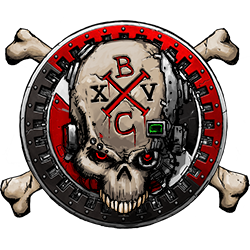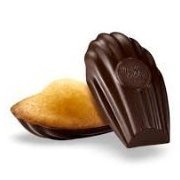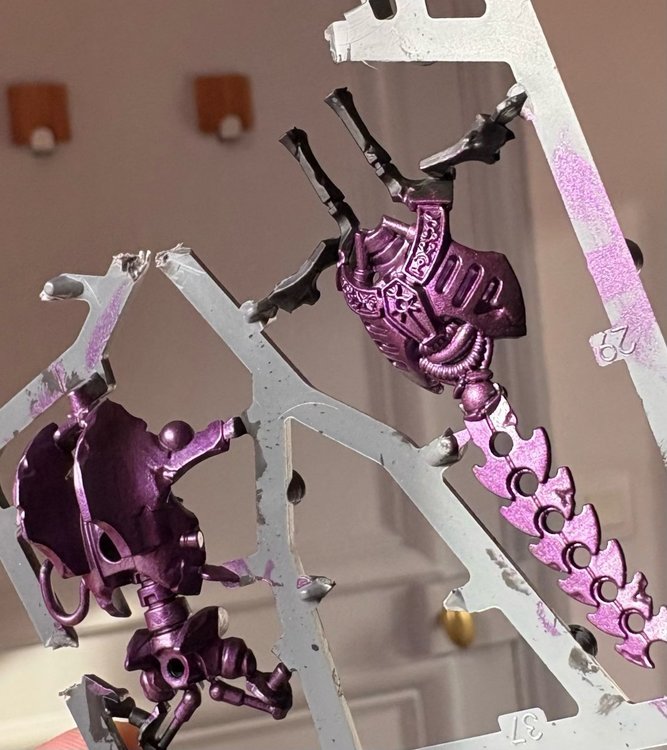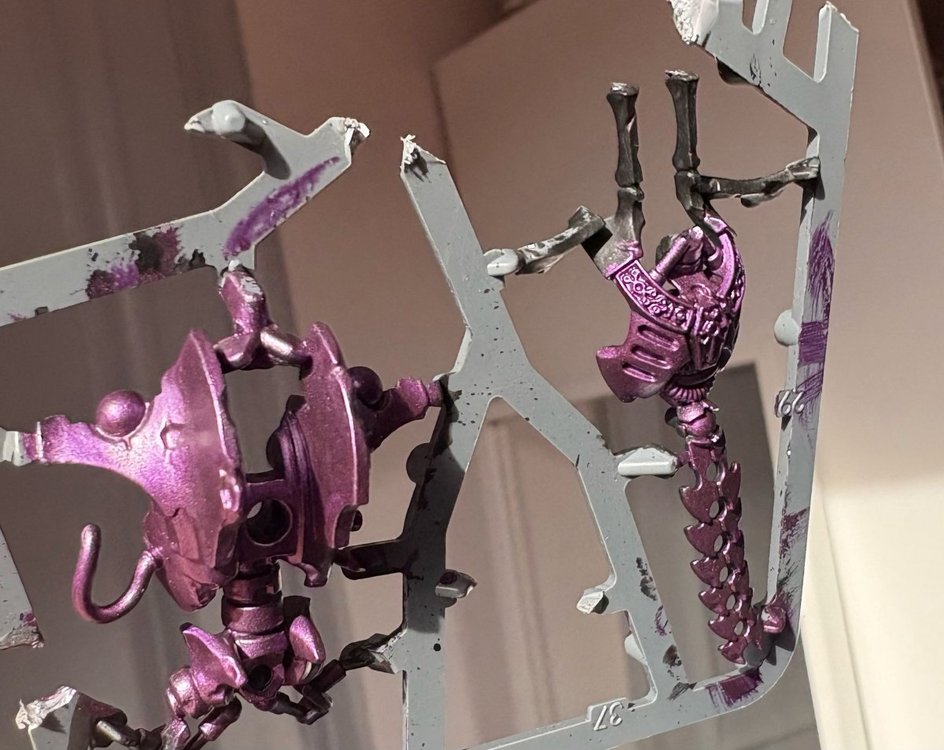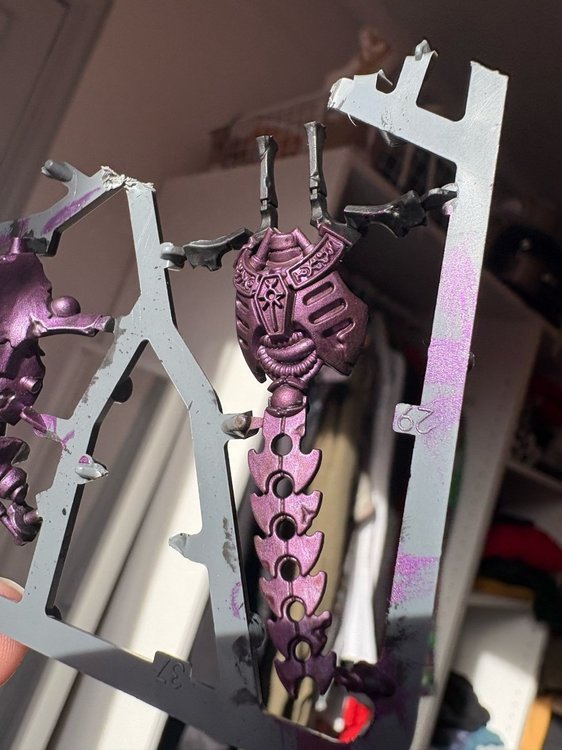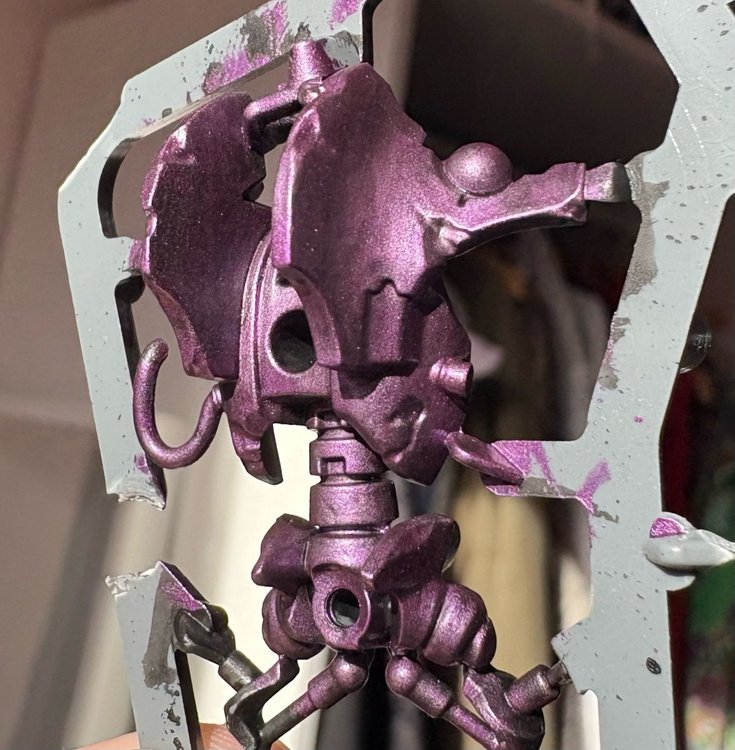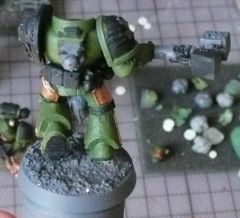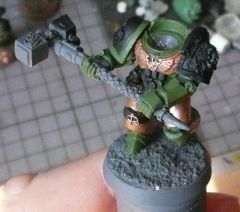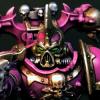Search the Community
Showing results for tags 'paint'.
-
Hello everyone! I thought I'd share my thoughts on this paint from Duncan's brand!! I ordered it as well as GSW's Persian Violet (which I have not yet received) to test out purples for my 30k Emperor's Children, and I tried it today!!! TL;DR: It's great!! Just a quick disclaimer: I'm by no means an accomplished or experienced painter: I have about 1k points of Necrons painted up, and that's about it!! But still wanted to give my opinion in case anyone else was considering this paint :))). So, to test it out, I used some unassembled parts I had lying around: these are the back and front bits of the Skorpekh Lord's body, I believe. I primed them with Abaddon Black (two thin coats of which, of course), then applied the paint as I would any other metallic (thinned down with some water): (Apologies for the picture quality) One somewhat thinned-down coat of Emperor's Purple basically covered all of it immediately, tho the big smooth "panels" on the back bit needed an additional coat (which seems pretty standard as far as metallic paints go, with a similar coverage to that of Leadbelcher, in my experience painting Necrons). Overall, very happy with the paint's coverage! It's such a pretty purple!!, and basically exactly what I wanted: a nice, metallic royal purple but with pink undertones, rather than blue. Of course, up close like this, you can kinda see the mica flakes, but irl it's a very smooth paint. Then, I wanted to see what it looked like shaded. On the front bit (in the above image, the bit that's to the right) I shaded with Reikland Fleshshade, and on the back bit (left) I used Nuln Oil. It's pretty hard to see on pictures, but the difference is *kinda* visible, so just in case, here's what I got!!: Shaded with Reikland Fleshshade ^ Shaded with Nuln Oil ^ The difference is really quite subtle, and even more so on the pictures, but you can still kinda see it: as expected, the Reikland Fleshshade made the tone a bit more redish, while the Nuln Oil darkened it slightly, and both do a reasonably-ish good job of highlighting recesses - tho perhaps I was didn't apply enough shade. The effect the Nuln Oil had is the most difficult to see on the pictures, but it really did darken it up, almost making the color a bit colder; and it feels like the Reikland Fleshshade matted the paint considerable more than its black counterpart, tho it's still visibly metallic and reflective. Definitely try this for yourself, as the difference isn't super apparent on camera, and is especially subtle with the amount of shade I used!! I think I will do more tests, applying more Nuln Oil but to just the recesses, as I love the bright color it has prior to the Nuln Oil treatment; if you want a darker metallic purple, try shading it completely!!! :D For more variation, I might see what applying a thin coat of Doomfire Magneta does, and could try Ardcoat to make it shinier/glossier!! But the purpose of this review is mainly to show the effect of the paint itself, which you can see in the first two pics!! I hope this was helpful to some!!!! Honestly, Emperor's Purple just feels like a purple Leadbelcher (as someone who uses that one a lot to paint my crons), which is definitely a compliment!! Great coverage, awesome color, what a great purple!! Definitely recommend!! :D
-
Hello! I've been really wanting to make a Xana II traitor knight army for Horus Heresy, and that of course requires a nice off-white / tan paint!! The issue is, I don't have an airbrush, and tbh they don't look very fun to use (I prefer brushing everything on!), so I'm looking for a paint that has good coverage and would be relatively easy to brush on a knight (with all their flat panels), or alternatively spray on (though this option is less favorable to me as I live in an apartment with no balcony so I'd have to either apply it inside, which I've heard is not a good idea, or go out onto the street or something). I have heard Rakarth Flesh recommended but figured it couldn't hurt having more options!!!! Furthermore, if you have examples of minis you've painted with the color, I'd love to see them!!! Especially if they're of Xanite origin Thanks!!! -Madeleine :3
-
Hello Fraters, I hope this is the right forum. I have some miniatures I want to strip paint of and someone recommended me an Ultrasonic bath. Could you confirm if this a good method? Is it worth it to buy one? What do you need to consider for buying or using one? Greetings, Kyknos
- 6 replies
-
- ultrasonic bath
- stripping
-
(and 1 more)
Tagged with:
-
10th edition has hit. Many new budding tyranid armys are sprouting from their spore sacks. They need colour and nids are less defined by such than probably any other army so share your schemes! lets get the inspiration going!!!
-
From the album: ETL IV
-
- Salamanders
- ETL IV
-
(and 4 more)
Tagged with:
-
From the album: ETL IV
-
- Salamanders
- ETL IV
-
(and 4 more)
Tagged with:
-
From the album: ETL IV
-
- Salamanders
- ETL IV
-
(and 4 more)
Tagged with:
-
From the album: ETL IV
-
- Salamanders
- ETL IV
-
(and 4 more)
Tagged with:
-
From the album: Paint Splatters
my first test necron/air brush job.. -
Well with the new Codex hitting it's time to dig out the old stuff I didn't get around to finishing. Last time around I had big plans to make a full battle company so it's not a small haul! http://i457.photobucket.com/albums/qq292/Troggman/Blood%20Angels/SDC14971_zps4fd1f9ce.jpg Ok a few bits I've picked up recently like the Dethstorm box, but it would have been rude not too! I'm allso realyl digin' the new assault terminators and tactical kits..... Must resist urge to buy more models..... Over the last week I've been cracking on with a few bits. I have built a few bikers that are in need of bases and 5 more sniper scouts to max out the squad. As well as assembly I've managed a bit of paint. http://i457.photobucket.com/albums/qq292/Troggman/Blood%20Angels/Tacgroupshot2_zps18a5a6fc.jpg http://i457.photobucket.com/albums/qq292/Troggman/Blood%20Angels/Sargecolse1_zps129678c6.jpg That drop pod is one of three I've been trying to get finished for 4 years now but as I was trying to batch paint them all I lost the will to live every time I tried. So this time I've gone for one at a time and I've finally got one finished... I know, chillout it's just s drop pod. I think next up will be a Stormraven, but it could as easy be a Furioso with pod. I may throw in Corbulo for kicks.... I'm still not sure how he's not been painted already!
-
It's taken me a long time to finally figure out this colour scheme and have gone through so many experiments and iterations, including stripping models and starting again but I've finally manged this: EC_CSM_001Front by Christopher Dean, on Flickr EC_CSM_001Side by Christopher Dean, on Flickr EC_CSM_001Rear by Christopher Dean, on Flickr
- 47 replies
-
I thought it would be reasonable to dedicate a thread to Agrax Earthshade (and other washes). Agrax Earthshade is used by Duncan in almost... everything and some people have taken to calling it Liquid Talent due to the great results you can get from it. To start: what is a wash. A wash or as GW markets them, a shade is a paint that is very fluid (usually the consistency of water or milk) that is translucent and has relatively little pigment. These characteristics are what give washes their role. When washes are applied, they tend to tint the model in the colour of the wash while allowing the base colour to shine through. This is most noticeable when you apply them to a light colour. Applying a green wash to a white model will leave you with a light green model due to the translucency of the paint allowing white to shine through. An example of this is where Cassandora Yellow is painting over a mostly white model to create a consistent, yellow model. This is one way to paint yellow armour for Imperial Fists: https://youtu.be/biqPX_uQ6m0?t=267 The high fluidity of washes is another key characteristics. GW calls them shades because when a wash is applied to a model, the liquid paint will tend to pool/flow into recesses. Since most of the pigment settles in the recesses, the recesses will have stronger colour. This allows you to easily add shadows to a model (remembering that a shadow is a dark colour in a recess. The opposite is a highlight, which is a light colour on a raised edge). An example of using a very thin, wash-like paint to add darkness to recesses is here, using Tamiya Panel Line Accent Colour: https://youtu.be/mDeuXW4hScA?t=80 The main uses of washes use their thin consistency and translucency to create shading effects in recesses, panel lines or curves. Another is to tint areas of a model in a colour while allowing the underlying colour to shine through, such as in the case of tinted flesh. Agrax Earthshade Agrax Earthshade is produced by Games Workshop and has achieved a meme status among some painters for its usefulness. Characteristically, Agrax Earthshade is simply a medium brown wash paint. It is in fact more expensive than other options like mixing your own washes or those from other companies, but due to the popularity of Duncan Rhodes' painting videos and of the hobby in general, this paint has become popular. Agrax Earthshade can be substituted with a brown paint of very thin consistency for any of its applications, although you might have a hard time getting a perfect colour match. Here are some of the uses for Agrax Earthshade. Feel free to add more: 1. Paint dirty, winter camouflage like this using white and Agrax Earthshade. First prime the model white or prime and paint it entirely white. Then cover the entire model in Agrax Earthshade. This will give it a ruddy brown tint. Then Drybrush white very heavily across the entire model to return it to white. This leaves Agrax Earthshade in the recesses, where they remain brown and add shadows while the rest of the model is white. This method avoids the traditional hassle of washing white models where you want to avoid getting brown paint where you don't want it. In this case, you get brown paint everywhere and then just build the white back up with drybrushing. 2. Use Agrax Earthshade in an airbrush to tint a model a darker shade. If you have a colour and want to tint it to a darker colour, airbrushing a wash over it can make it dramatically darker. Airbrushing also gives you control over how much tint you use. This can be used to create rather unique colours and gradients. This model uses Tamiya Flat Red as a base, but Tamiya Flat Red is very bright. Progressive layers of Agrax Earthshade airbrushed onto the model darken the model. 3. Brown, oily metal. One of the classic ways to get brown, oily metal with a bit of depth is to start with a grey metallic colour like Leadbelcher and simply cover it in Agrax Earthshade. The shade flows into recesses adding depth and tints the model brown, as seen here. 4. Washing down bright foliage. If you have bought or painted brightly coloured flora and foliage (like from a pet store) and want to darken it, a simple way is to cover it in Agrax Earthshade. The brown hue is common to soil, dirt and dust in nature and will tint the terrain a darker colour. 5. Gehenna's Gold + Agrax Earthshade = easy, rich gold. Seen here on the banner. Methods using washes in general 1. Speedpainting surfaces. Using washes is a foundation of speedpainting. Washes cover models easily while simultaneously applying colour and shading them. Their translucency lets them blend naturally into other colours so mistakes are harder to see and their translucency is also easy to paint over using other colours to cover mistakes. Entire armies can be painted quickly by mixing washes over a light grey/white surface with normal painting techniques. Duncan Rhodes paints a poxwalker very quickly using green wash over white to make pallid green flesh, then only picking out basic details like trousers, then washing with Agrax Earthshade to tie the model together. 2. Painting yellow or other light-coloured armies. Light colours have a bad reputation because it is easy to see mistakes on a bright surface. Traditionally, painting armies with light colours is time-consuming due to the need for precise brushwork, precise thinning and many layers. One easy way to paint colours like Imperial Fists yellow is to start with a white base and simply wash the model using a wash to tint it that colour. Take care to make sure the wash does not pool on flat surfaces. An example involving painting Imperial Fists yellow is here: https://youtu.be/biqPX_uQ6m0?t=267 3. Simultaneously painting and shading flesh. Starting with a grey base and simply washing the area in a flesh-tinted wash immediately tints it in your colour of choice while also shading the recesses of musculature. Examples here and here using Athonian Camoshade and Reaper Flesh Shade 4. Rapid shading and model protection using Army Painter Quick Shade. Army Painter produces a line of products called Quick Shade, which are essentially thinned wood varnishes. Rather than painting a model with it, you dip the entire model in like some kind of baby Achilles and let the excess drip off. When it dries, your entire model is shaded and tinted and the paint is formulated to leave a protective coat over the model as well. Example here. 5. Multi-colour heat burn effects. Washes of different tones applied to a metallic surface can be used to easily create a gradient reminiscent of burns on a metal surface, such as flamethrower or jet engine nozzles. Duncan Rhodes shows the technique using 3 washes here. That's all I have. Add more entertaining uses for washes in the comments!
-
I've been having a lot of trouble with a few paints recently, namely Zandri Dust, Celestra Grey, Ushabti Bone, And White Scar. When I paint them on the models the paint seems to clump slightly and result in a chalky texture. At first I thought that I needed to add more water, but that seems to make it worse. Using very little water helps but I am worried about obscuring detail. I am using a wet pallet when thinning my paints and all the paints I'm getting this with are new, just being obtained in the last 6 months or so. Is there any advice from people who have had similar issues? Or is this just something that I'm going to have to practice more to get the hang of?
